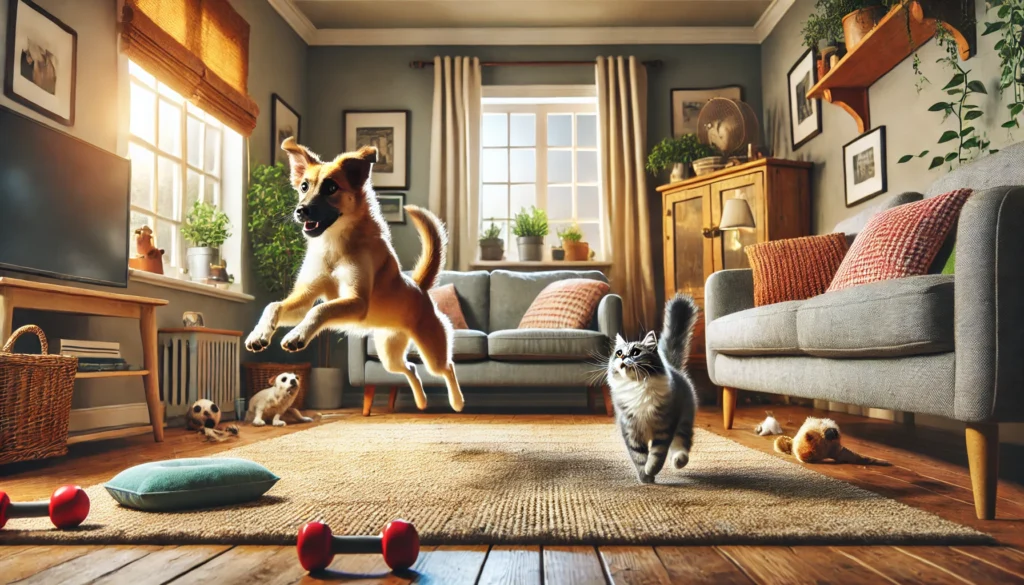If you’ve ever witnessed your dog suddenly tear around the house or your cat go from relaxed to leaping off furniture at lightning speed — you’ve seen “the zoomies.” These intense, random bursts of energy are perfectly normal and often hilarious, but when they happen indoors, they can be overwhelming, messy, or even dangerous.
Whether you’re dealing with a zoomie-prone pup or a hyper kitten, this guide will teach you how to understand, manage, and even embrace the zoomies — while keeping your space and your pet safe.
What Are Zoomies?
Zoomies, officially called Frenetic Random Activity Periods (FRAPs), are brief episodes of high energy. Your pet might sprint in circles, dart up and down hallways, spin, leap on furniture, or bounce unpredictably from one room to another.
Common triggers include:
- Post-bath or grooming
- After eating
- Post-poop (especially in dogs)
- Boredom or overstimulation
- Release of pent-up energy
- Stress relief (especially after confinement)
Zoomies are more common in puppies and kittens but can occur at any age.
Why Do Pets Get the Zoomies?
Zoomies are a natural outlet for excess physical and emotional energy. They help pets:
- Release tension after inactivity
- Express joy, especially during play
- Reset their energy after something stressful (like a bath)
- Burn energy quickly in small spaces
- Communicate excitement or relief
They are generally harmless — but they can become problematic if not managed properly.
Are Zoomies a Problem?
In moderation, no. Zoomies are normal and even healthy. However, they can become concerning if:
- Your pet knocks things over or slips frequently
- They happen too often due to lack of exercise
- They cause damage to furniture, walls, or flooring
- Your pet seems disoriented or overly aroused after
- You or others get accidentally injured during a zoomie session
Understanding the cause and frequency is key to managing zoomies effectively.
How to Safely Handle Dog Zoomies Indoors
1. Clear a Safe Path
- Remove obstacles like furniture with sharp corners
- Block access to slippery floors with rugs or mats
- Use baby gates to keep dogs out of small or unsafe rooms
2. Redirect With Toys
If your dog starts a zoomie session, toss a soft toy into a clear area to guide their path.
- Try plush toys, rope toys, or soft balls
- Avoid hard toys that can cause damage or injury indoors
3. Stay Calm and Let It Pass
Don’t yell or chase. This can increase arousal. Instead:
- Step aside and let them zoom in a safe area
- Wait for them to finish before re-engaging
- Offer calm praise and water when they slow down
4. Anticipate Patterns
If zoomies happen at predictable times (e.g., every evening), try scheduling a walk or structured play just before to release energy.
5. Offer a Cool Down Routine
After zoomies, guide your dog to a mat, crate, or bed and offer:
- A lick mat
- A calming chew
- A gentle brushing session
This teaches them how to shift from high to low energy naturally.
How to Manage Cat Zoomies Indoors
1. Let Them Zoom — Safely
Cats often zoom at dawn or dusk (crepuscular instinct). Clear pathways and ensure no breakables are in their “run zone.”
- Block off fragile areas with barriers
- Use soft rugs or mats to reduce skidding
2. Add Daily Playtime
Cats zoom to mimic the hunt. Simulate this with:
- Wand toys (mimicking birds or mice)
- Feather teasers
- Laser pointers (with physical toy reward at the end)
Play for 10–15 minutes, ideally at times they usually zoom.
3. Rotate Enrichment
Offer:
- Puzzle feeders
- Cat trees or climbing shelves
- Tunnels and hideouts
- New textures or cardboard boxes
This prevents boredom-based zooming.
4. Avoid Punishment
Never yell, spray, or punish your cat for zooming. It’s instinctual and can cause anxiety.
5. Respect Zoomie Time
If your cat is zooming every night at 9 PM, accept that as their routine. Offer stimulation earlier in the evening and plan quiet time after.
When Zoomies Might Signal a Problem
In rare cases, excessive or unusual zoomies may indicate:
- Lack of proper exercise or mental enrichment
- Stress or frustration
- Neurological issues (especially if followed by confusion or imbalance)
- Hyperactivity in certain breeds or high-energy animals
If your pet shows signs of injury, agitation, or obsessive behavior after zoomies, consult a vet.
How to Encourage Healthier Outlets for Energy
Zoomies are normal, but they shouldn’t be the only form of exercise. Add daily outlets:
- Walks (even indoor leash walks for small dogs)
- Trick training sessions
- Interactive toys and scent games
- Obstacle courses or agility setups
- Chill time in a pet-safe relaxation space
Burning energy gradually throughout the day prevents buildup that leads to zoomie explosions.
Zoomies = Joy, Not Rebellion
Zoomies might look wild, but they’re not bad behavior. They’re spontaneous joy, release, and expression. Your pet is simply letting go of whatever built up — and that’s something to appreciate (safely).
As long as the space is secure and they’re healthy, zoomies are just part of life with a happy pet.






